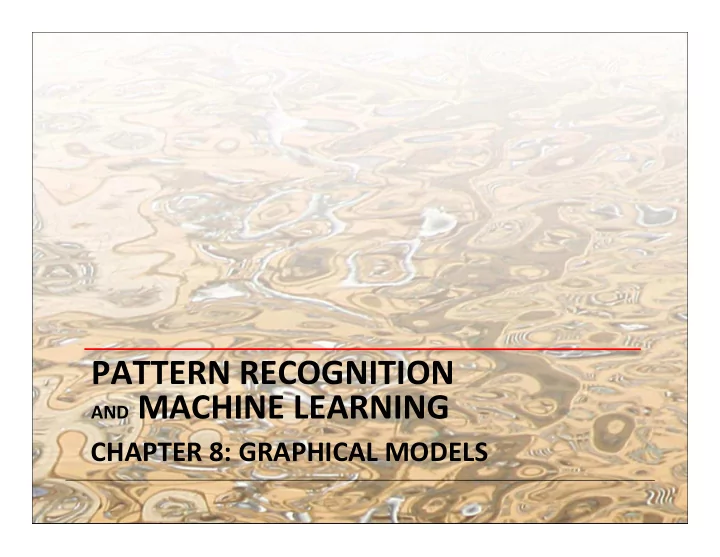

PATTERN RECOGNITION AND MACHINE LEARNING CHAPTER 8: GRAPHICAL MODELS
Bayesian Networks Directed Acyclic Graph (DAG)
Bayesian Networks General Factoriza;on
Bayesian Curve Fi?ng (1) Polynomial
Bayesian Curve Fi?ng (2) Plate
Bayesian Curve Fi?ng (3) Input variables and explicit hyperparameters
Bayesian Curve Fi?ng—Learning Condi;on on data
Bayesian Curve Fi?ng—Predic;on Predic;ve distribu;on: where
Genera;ve Models Causal process for genera;ng images
Discrete Variables (1) General joint distribu;on: K 2 { 1 parameters Independent joint distribu;on: 2(K { 1) parameters
Discrete Variables (2) General joint distribu;on over M variables: K M { 1 parameters M ‐node Markov chain: K { 1 + (M { 1) K(K { 1) parameters
Discrete Variables: Bayesian Parameters (1)
Discrete Variables: Bayesian Parameters (2) Shared prior
Parameterized Condi;onal Distribu;ons If are discrete, K ‐state variables, in general has O(K M ) parameters. The parameterized form requires only M + 1 parameters
Linear‐Gaussian Models Directed Graph Each node is Gaussian, the mean is a linear func;on of the parents. Vector‐valued Gaussian Nodes
Condi;onal Independence a is independent of b given c Equivalently Nota;on
Condi;onal Independence: Example 1
Condi;onal Independence: Example 1
Condi;onal Independence: Example 2
Condi;onal Independence: Example 2
Condi;onal Independence: Example 3 Note: this is the opposite of Example 1, with c unobserved.
Condi;onal Independence: Example 3 Note: this is the opposite of Example 1, with c observed.
“Am I out of fuel?” B = Ba[ery (0=flat, 1=fully charged) F = Fuel Tank (0=empty, 1=full) and hence G = Fuel Gauge Reading (0=empty, 1=full)
“Am I out of fuel?” Probability of an empty tank increased by observing G = 0 .
“Am I out of fuel?” Probability of an empty tank reduced by observing B = 0 . This referred to as “explaining away”.
D‐separa;on • A , B , and C are non‐intersec;ng subsets of nodes in a directed graph. • A path from A to B is blocked if it contains a node such that either a) the arrows on the path meet either head‐to‐tail or tail‐ to‐tail at the node, and the node is in the set C , or b) the arrows meet head‐to‐head at the node, and neither the node, nor any of its descendants, are in the set C . • If all paths from A to B are blocked, A is said to be d‐ separated from B by C . • If A is d‐separated from B by C , the joint distribu;on over all variables in the graph sa;sfies .
D‐separa;on: Example
D‐separa;on: I.I.D. Data
Directed Graphs as Distribu;on Filters
The Markov Blanket Factors independent of x i cancel between numerator and denominator.
Markov Random Fields Markov Blanket
Cliques and Maximal Cliques Clique Maximal Clique
Joint Distribu;on where is the poten;al over clique C and is the normaliza;on coefficient; note: M K ‐state variables → K M terms in Z . Energies and the Boltzmann distribu;on
Illustra;on: Image De‐Noising (1) Original Image Noisy Image
Illustra;on: Image De‐Noising (2)
Illustra;on: Image De‐Noising (3) Noisy Image Restored Image (ICM)
Illustra;on: Image De‐Noising (4) Restored Image (ICM) Restored Image (Graph cuts)
Conver;ng Directed to Undirected Graphs (1)
Conver;ng Directed to Undirected Graphs (2) Addi;onal links
Directed vs. Undirected Graphs (1)
Directed vs. Undirected Graphs (2)
Inference in Graphical Models
Inference on a Chain
Inference on a Chain
Inference on a Chain
Inference on a Chain
Inference on a Chain To compute local marginals: • Compute and store all forward messages, . • Compute and store all backward messages, . • Compute Z at any node x m • Compute for all variables required.
Trees Undirected Tree Directed Tree Polytree
Factor Graphs
Factor Graphs from Directed Graphs
Factor Graphs from Undirected Graphs
The Sum‐Product Algorithm (1) Objec;ve: i. to obtain an efficient, exact inference algorithm for finding marginals; ii. in situa;ons where several marginals are required, to allow computa;ons to be shared efficiently. Key idea: Distribu;ve Law
The Sum‐Product Algorithm (2)
The Sum‐Product Algorithm (3)
The Sum‐Product Algorithm (4)
The Sum‐Product Algorithm (5)
The Sum‐Product Algorithm (6)
The Sum‐Product Algorithm (7) Ini;aliza;on
The Sum‐Product Algorithm (8) To compute local marginals: • Pick an arbitrary node as root • Compute and propagate messages from the leaf nodes to the root, storing received messages at every node. • Compute and propagate messages from the root to the leaf nodes, storing received messages at every node. • Compute the product of received messages at each node for which the marginal is required, and normalize if necessary.
Sum‐Product: Example (1)
Sum‐Product: Example (2)
Sum‐Product: Example (3)
Sum‐Product: Example (4)
The Max‐Sum Algorithm (1) Objec;ve: an efficient algorithm for finding i. the value x max that maximises p(x) ; ii. the value of p(x max ) . In general, maximum marginals ≠ joint maximum.
The Max‐Sum Algorithm (2) Maximizing over a chain (max‐product)
The Max‐Sum Algorithm (3) Generalizes to tree‐structured factor graph maximizing as close to the leaf nodes as possible
The Max‐Sum Algorithm (4) Max‐Product → Max‐Sum For numerical reasons, use Again, use distribu;ve law
The Max‐Sum Algorithm (5) Ini;aliza;on (leaf nodes) Recursion
The Max‐Sum Algorithm (6) Termina;on (root node) Back‐track, for all nodes i with l factor nodes to the root ( l=0 )
The Max‐Sum Algorithm (7) Example: Markov chain
The Junc;on Tree Algorithm • Exact inference on general graphs. • Works by turning the ini;al graph into a junc)on tree and then running a sum‐ product‐like algorithm. • Intractable on graphs with large cliques.
Loopy Belief Propaga;on • Sum‐Product on general graphs. • Ini;al unit messages passed across all links, aler which messages are passed around un;l convergence (not guaranteed!). • Approximate but tractable for large graphs. • Some;me works well, some;mes not at all.
Recommend
More recommend